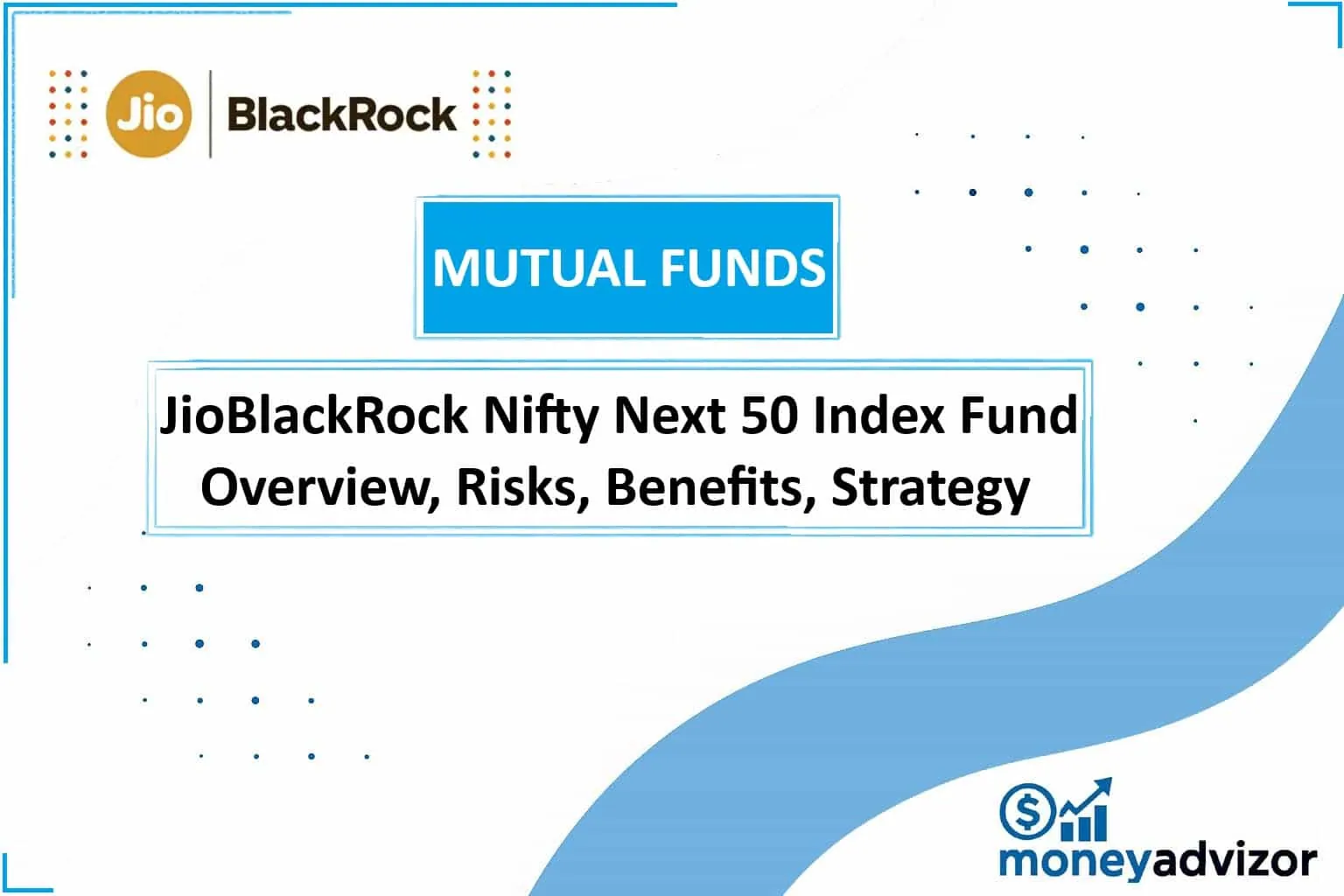The Indian mutual fund landscape continues to evolve, offering investors increasingly sophisticated tools to access the equity market. One such tool, designed for those seeking exposure beyond the largest blue-chips, is the JioBlackRock Nifty Next 50 Index Fund. Launched by the powerhouse collaboration of Jio Financial Services and global asset management giant BlackRock, this fund aims to democratize access to India’s next generation of leading companies. This article provides a comprehensive analysis of this new entrant, exploring its structure, strategy, benefits, risks, and suitability.
What is the JioBlackRock Nifty Next 50 Index Fund?
It’s an open-ended index fund. Its primary objective is straightforward: to replicate or track the performance of the Nifty Next 50 Index (TRI – Total Returns Index), before accounting for expenses and subject to tracking error. Simply put, it aims to mirror the returns generated by the 50 companies that follow the top 50 (Nifty 50) in terms of market capitalization within the Nifty 100 universe.
- Category: Other Schemes – Index Fund
- Benchmark: Nifty Next 50 Index (TRI)
- Risk Profile: Very High (as per SEBI Risk-o-meter, aligning with the benchmark’s risk).
- Structure: Offers only a Direct Plan with a Growth Option initially. No entry load and currently Zero Exit Load.
- Minimum Investment:
- During NFO & Ongoing: Lumpsum – Rs. 500 and any amount thereafter.
- SIP – Rs. 500 per installment (Minimum 6 installments for Weekly/Monthly/Quarterly frequencies).
Why the Nifty Next 50 Index?
The Nifty Next 50 Index represents a crucial segment of the Indian equity market:
- Beyond the Giants: It captures companies ranked 51 to 100 by full market capitalization within the Nifty 100. These are established, large-cap companies poised for potential growth, often seen as the future leaders.
- Diversification: Investing in this index provides diversification beyond the saturated Nifty 50 names, potentially tapping into emerging sectors and faster-growing companies.
- Growth Potential: Historically, the Next 50 index has often offered higher growth potential than the Nifty 50, albeit with higher volatility. It represents a blend of established players and emerging champions.
- Transparent & Rules-Based: The index methodology (free-float market cap weighted) is transparent, with semi-annual rebalancing (March & September) and quarterly checks for compliance with SEBI portfolio concentration norms.
Key Features and Benefits
- Passive Investment Strategy:
- The fund employs a passive management approach. It doesn’t try to “beat” the market through stock picking or market timing. Instead, it focuses on minimizing tracking error – the deviation between the fund’s performance and the index’s performance.
- This strategy typically results in lower expense ratios compared to actively managed funds, as there’s no high-cost research team constantly analyzing stocks. The estimated Total Expense Ratio (TER) cap is up to 1.00% p.a. of daily net assets (plus applicable GST on investment management fees). Actual TER will be disclosed post-NFO.
- Transparency and Low Costs (Direct Plan):
- Offering only the Direct Plan eliminates distributor commissions, ensuring the TER is solely for fund management and operational costs, maximizing returns for investors.
- No Transaction Charges: Investors aren’t levied transaction charges, although a nominal stamp duty (0.005%) applies on applicable purchases.
- Systematic Investment Options:
- SIP: Allows disciplined investing starting at Rs. 500 per installment (min 6 installments). Features like SIP Top-Up (increase amount periodically) and SIP Pause (temporarily halt for 1-6 months) enhance flexibility.
- STP (Systematic Transfer Plan): Transfer fixed amounts regularly from this fund to other JioBlackRock open-ended schemes (min Rs. 100 per installment, min 6 installments). Available only post-NFO.
- SWP (Systematic Withdrawal Plan): Generate regular income by withdrawing fixed amounts periodically (min Rs. 500 per installment, min 6 installments). Available only post-NFO.
- Diversification: Provides exposure to 50 leading large-cap companies across various sectors, reducing single-stock risk inherent in direct equity investments.
- Accessibility: Low minimum investment makes it accessible to a broad range of investors.
Important Scheme Documents: Mutual Fund Draft at SEBI
Understanding the Risks (Very High)
Investing in this fund carries significant risks inherent to equity markets and passive index strategies:
- Market Risk: The fund’s value fluctuates with the Nifty Next 50 Index. Economic downturns, interest rate changes, geopolitical events, or sector-specific issues can lead to negative returns.
- Concentration Risk: While diversified across 50 stocks, the portfolio is concentrated within the index constituents. Underperformance of key stocks or sectors can significantly impact the NAV.
- Index Tracking Error Risk: The fund may not perfectly replicate the index due to:
- Fund expenses.
- Holding cash for redemptions.
- Corporate actions (dividends, rights issues, mergers).
- Trading restrictions (circuit filters, liquidity issues).
- Rounding of share quantities.
- Timing differences in trades.
- The fund targets an annualized tracking error (based on 1-year rolling data) not exceeding 2% under normal conditions.
- Liquidity Risk: Some index constituents might have lower trading volumes. During market stress or circuit filters, selling these stocks to meet redemptions might be difficult or lead to unfavorable prices, causing tracking error and potential losses.
- Passive Management Risk: The fund doesn’t avoid declining stocks within the index. It fully participates in both the upside and downside of the index.
- Regulatory and Taxation Risk: Changes in laws, regulations (like SEBI rules), or tax policies can impact the fund’s operations or returns.
- Derivatives Risk (Limited Use): The fund may use index futures temporarily (up to 20% of net assets for non-hedging) during index rebalancing or corporate actions when underlying stocks are unavailable. Derivatives carry leverage risk, market risk, liquidity risk, and counterparty risk.
- Securities Lending Risk (Up to 20%): Engaging in securities lending introduces counterparty default risk and potential temporary illiquidity of lent securities.
- New Fund Risk: As a new scheme, there’s no historical performance data or established tracking record for this specific fund.
How the Fund Works: Strategy and Mechanics
- Asset Allocation:
- Equity & Equity Related: 95% – 100% (Stocks comprising the Nifty Next 50 Index).
- Debt, Money Market & Cash Equivalents: 0% – 5% (For liquidity, managing inflows/outflows, or temporary defensive positioning).
- Portfolio Construction: The fund invests in the constituents of the Nifty Next 50 Index in the same proportion as the index.
- Rebalancing:
- Index Changes: When the index composition changes (semi-annual rebalance or corporate actions), the fund must rebalance its portfolio within 7 calendar days to mirror the new index.
- Short-Term Defensive Shifts: If the fund deviates from its core equity allocation (e.g., holds more cash temporarily due to market conditions), it must return to the target allocation within 7 calendar days.
- Deployment of Funds: NFO proceeds must be deployed within 30 business days of allotment, extendable by another 30 days with Investment Committee approval under exceptional circumstances.
- Derivatives Usage: Limited to index futures for short durations during rebalancing events, adhering to strict SEBI limits on exposure and position sizes.
- Securities Lending: Permitted up to 20% of net assets (max 5% with a single intermediary) to generate additional income, subject to SEBI guidelines.
- Prohibited Investments: The fund will not invest in unlisted debt, securitized debt, overseas securities, credit default swaps, short selling, debt derivatives, AT1/AT2 bonds, bespoke debt products, or fund of funds schemes.
The Fund Management Team
The fund is managed by a team of experienced professionals:
- Ms. Tanvi Kacheria (Managing since inception): CFA Charterholder with experience at JioBlackRock, Jio Financial Services, BlackRock (US), and Los Angeles Capital Management.
- Mr. Anand Shah (Managing since inception): PGDBA with over 23 years of experience, including roles at JioBlackRock, Jio Financial Services, Aditya Birla Sun Life Insurance, BOI AXA, Zyfin Capital, and Daiwa Asset Management.
- Mr. Haresh Mehta (Managing since inception): MBA, CFA Level 1, with experience at JioBlackRock, Bajaj Finserv AMC, Aditya Birla Sun Life AMC, Baroda BNP Paribas AMC, and First Global.
Who Should Consider This Fund?
- Investors with a Long-Term Horizon (7-10+ years): Equity investments, especially in growth-oriented segments like the Next 50, require time to potentially weather volatility and capture growth.
- Investors Seeking Large-Cap Growth Exposure: Those wanting diversification beyond the Nifty 50 and exposure to potential future market leaders.
- Believers in Passive Investing: Investors who prefer low-cost, transparent, rules-based strategies over active stock picking.
- Investors with High Risk Appetite: Willing to accept significant volatility inherent in equity markets and concentrated index strategies.
- SIP Investors: Ideal for building wealth systematically over the long term, benefiting from rupee cost averaging.
How to Invest
- During NFO: Applications can be submitted physically at Official Points of Acceptance (OPAs – list on AMC website) or electronically via:
- JioBlackRock AMC Website/Mobile App
- CAMS Website/Mobile App (myCAMS)
- BSE StAR MF, NSE NMF II, MF Utilities (MFU) platforms
- Demat mode applicants can use ASBA facility via Self-Certified Syndicate Banks (SCSBs).
- Post-NFO (Continuous Offer): Same channels as NFO, plus Systematic Plans (SIP, STP, SWP).
- Cut-off Time: 3:00 PM for same-day NAV applicability for both purchases (if funds realized) and redemptions.
For More Information & Complete Guide: Check How to invest in JioBlackRock Mutual Fund Simple Guide
Taxation
- Growth Option: Capital Gains Tax applies upon redemption.
- Short-Term Capital Gains (STCG): If units held for ≤ 12 months. Taxed at 15%.
- Long-Term Capital Gains (LTCG): If units held for > 12 months. Gains exceeding Rs. 1 lakh in a financial year are taxed at 10% without indexation benefit.
- (Potential Future) IDCW Option: Income Distribution cum Capital Withdrawal (IDCW) payouts are added to the investor’s income and taxed according to their income slab. A TDS of 10% may apply if the total IDCW in a financial year exceeds Rs. 5,000.
- Investors should consult a tax advisor for personalized advice based on their specific circumstances.
Conclusion: A Strategic Tool for Core Portfolio Allocation
The JioBlackRock Nifty Next 50 Index Fund emerges as a significant addition to the Indian passive investing ecosystem. Backed by the formidable partnership of Jio and BlackRock, it offers a low-cost, transparent, and efficient vehicle to gain exposure to a critical segment of the Indian equity market – the companies positioned just below the giants, often characterized by strong growth potential.
Its pure passive approach, focus on minimizing tracking error, and availability only through the Direct Plan are strong positives for cost-conscious, long-term investors. The inclusion of flexible systematic investment and withdrawal plans further enhances its utility.
However, the “Very High” risk rating is paramount. This fund is suitable only for investors who fully understand and accept the inherent volatility of equity markets, the specific risks of a concentrated index strategy (including tracking error and liquidity constraints), and possess a genuinely long investment horizon. It should be considered a core satellite holding within a well-diversified portfolio, complementing other asset classes and potentially the Nifty 50 exposure.
For investors seeking disciplined exposure to India’s next wave of large-cap leaders through a reputable, low-cost passive structure, the JioBlackRock Nifty Next 50 Index Fund warrants serious consideration, keeping its risk profile firmly in mind.




